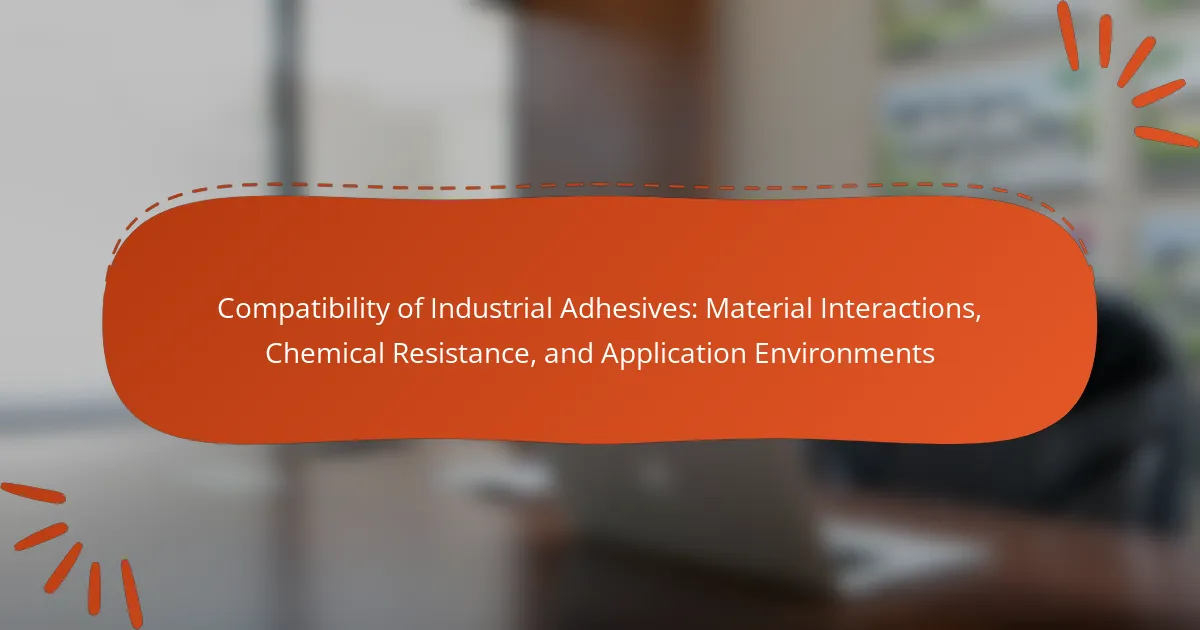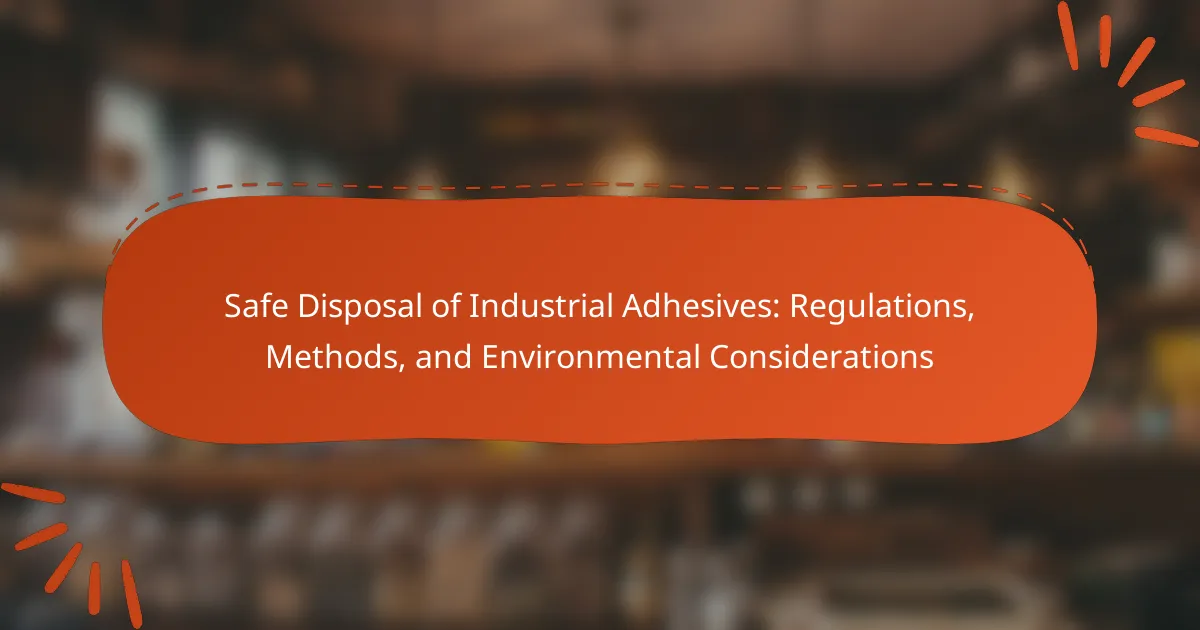The compatibility of industrial adhesives is crucial for ensuring effective bonding with various materials, including metals, plastics, ceramics, and wood. This compatibility is determined by the chemical composition of both the adhesive and the substrate, influencing performance and durability. Key factors in assessing adhesive compatibility include adhesion strength, chemical resistance, and environmental conditions such as temperature and humidity. Manufacturers provide compatibility charts and performance data to assist users in selecting the appropriate adhesive for specific applications. Proper surface preparation and testing under real-world conditions are essential for achieving optimal results in adhesive bonding.

What is the Compatibility of Industrial Adhesives?
The compatibility of industrial adhesives refers to their ability to bond effectively with various materials. This compatibility is influenced by the chemical composition of both the adhesive and the substrate. Industrial adhesives can be compatible with metals, plastics, ceramics, and wood, depending on their formulation. For example, epoxy adhesives typically bond well with metals and some plastics. In contrast, silicone adhesives excel in bonding with flexible materials and withstand high temperatures. Testing for compatibility is crucial, as it ensures optimal performance and durability of the adhesive bond. Manufacturers often provide compatibility charts to guide users in selecting the right adhesive for specific materials.
How do different materials interact with industrial adhesives?
Different materials interact with industrial adhesives based on their surface energy, porosity, and chemical composition. High surface energy materials, like metals, generally bond well with adhesives due to strong intermolecular forces. Conversely, low surface energy materials, such as some plastics, may require surface treatments to improve adhesion. Porous materials, like wood, can absorb adhesives, affecting bond strength and curing time. Chemical compatibility is crucial; for example, solvents in adhesives can degrade certain plastics. Testing is essential to ensure proper adhesion for specific material combinations.
What factors influence material compatibility with adhesives?
Material compatibility with adhesives is influenced by several key factors. These factors include the surface energy of the materials, which affects adhesion strength. The chemical composition of both the adhesive and the substrate plays a crucial role in compatibility. Physical properties such as porosity and texture can also impact how well an adhesive bonds to a material. Environmental conditions, including temperature and humidity, can alter adhesive performance. Additionally, the presence of contaminants on surfaces may hinder adhesion. Understanding these factors is essential for selecting the right adhesive for specific materials.
How do surface properties affect adhesive bonding?
Surface properties significantly impact adhesive bonding. The roughness, cleanliness, and chemical composition of surfaces influence how well adhesives adhere. Rough surfaces increase the contact area, enhancing mechanical interlocking. Clean surfaces remove contaminants that can weaken bonds, ensuring stronger adhesion. Chemical properties, such as polarity and functional groups, dictate the interaction between the adhesive and the substrate. For example, polar surfaces promote stronger hydrogen bonding with polar adhesives. Studies show that surface treatments can enhance adhesion by modifying these properties. For instance, plasma treatment can increase surface energy, improving bond strength.
What role does chemical resistance play in adhesive compatibility?
Chemical resistance is crucial for adhesive compatibility. It determines how well an adhesive can withstand exposure to various chemicals without degrading. High chemical resistance ensures that the adhesive maintains its bond strength and integrity in harsh environments. For instance, adhesives used in automotive applications must resist fuels and oils. If an adhesive lacks chemical resistance, it can fail, leading to structural issues. Therefore, selecting adhesives with appropriate chemical resistance is essential for successful applications. This selection process is supported by industry standards that specify chemical compatibility requirements for different materials.
Which chemicals commonly affect industrial adhesives?
Common chemicals that affect industrial adhesives include solvents, acids, bases, and moisture. Solvents like acetone and toluene can weaken adhesive bonds. Acids such as hydrochloric acid can cause degradation of adhesive materials. Bases, including sodium hydroxide, may also negatively impact adhesive integrity. Moisture can lead to hydrolysis, compromising adhesive strength. These interactions can vary based on the adhesive type, affecting performance in different environments. Understanding these chemical effects is crucial for selecting the right adhesive for specific applications.
How can chemical resistance be tested in adhesives?
Chemical resistance in adhesives can be tested through various standardized methods. One common method is immersion testing, where adhesive samples are submerged in specific chemicals for a set duration. The samples are then evaluated for changes in physical properties, such as tensile strength and adhesion. Another approach is surface contact testing, which involves applying chemicals directly to the adhesive surface and assessing degradation over time.
Additionally, accelerated aging tests can simulate long-term exposure to chemicals in a shorter timeframe. These tests involve exposing adhesives to elevated temperatures and humidity alongside chemical agents. The results from these tests provide insight into how adhesives will perform in real-world applications.
Standards such as ASTM D 543 outline procedures for testing chemical resistance in materials, including adhesives. Following these standards ensures consistency and reliability in testing outcomes.
What are the common application environments for industrial adhesives?
Common application environments for industrial adhesives include manufacturing, construction, automotive, aerospace, and electronics. In manufacturing, adhesives bond materials in assembly processes. In construction, they secure structural components and finishes. The automotive industry uses adhesives for assembling parts and enhancing durability. Aerospace applications often require adhesives for lightweight and strong bonds. Electronics rely on adhesives for circuit board assembly and component attachment. Each environment demands specific adhesive properties like strength, temperature resistance, and chemical compatibility.
How do temperature and humidity impact adhesive performance?
Temperature and humidity significantly impact adhesive performance. High temperatures can accelerate curing times but may also lead to premature failure. Low temperatures can slow down the curing process, resulting in weak bonds. Humidity affects the moisture content in adhesives, which can lead to hydrolysis in water-sensitive adhesives. High humidity can cause adhesives to absorb moisture, weakening their bond strength. Conversely, low humidity can lead to rapid evaporation of solvents in solvent-based adhesives, potentially causing surface defects. Studies have shown that adhesive performance can vary by as much as 50% based on temperature and humidity conditions. For example, a study by the National Institute of Standards and Technology found that temperature variations can alter the shear strength of adhesives by significant margins.
What considerations are there for outdoor versus indoor applications?
Outdoor applications require adhesives to withstand environmental factors like UV exposure, moisture, and temperature fluctuations. Indoor applications typically face fewer environmental stresses, allowing for a wider range of adhesive options.
Outdoor adhesives must have high weather resistance to prevent degradation. They should also offer superior bonding strength to handle dynamic forces from wind and temperature changes. Indoor adhesives can prioritize ease of application and aesthetic qualities since they are shielded from harsh conditions.
Additionally, outdoor adhesives often need to be formulated with additives to enhance durability against elements. Indoor adhesives may focus more on low VOC emissions for better indoor air quality. Understanding these differences is crucial for selecting the right adhesive for each environment.

How can one assess adhesive compatibility?
To assess adhesive compatibility, one must evaluate the interaction between the adhesive and the substrates. This involves testing for adhesion strength on the materials in question. Compatibility can also be assessed through chemical resistance tests. These tests determine how the adhesive reacts to various environmental conditions. Conducting peel tests and shear tests provides quantitative data on adhesion performance. Observing changes in physical properties after exposure to specific conditions is essential. Finally, consulting manufacturer specifications for compatibility guidelines is vital.
What tests are available to evaluate adhesive compatibility?
Adhesive compatibility can be evaluated using several tests. Common tests include peel tests, shear tests, and tensile tests. Peel tests measure the force required to separate two bonded surfaces. Shear tests assess the adhesive’s ability to resist sliding forces. Tensile tests evaluate the adhesive bond strength under stretching conditions. Additional tests may involve environmental exposure assessments. These tests simulate real-world conditions to determine performance. Each test provides insights into the adhesive’s effectiveness with specific materials.
How do peel and shear tests measure adhesion strength?
Peel and shear tests measure adhesion strength by applying forces to an adhesive bond. Peel tests assess the force required to separate two bonded surfaces at an angle. Shear tests measure the force needed to slide one bonded surface over another.
In peel tests, the force is applied perpendicular to the bond line. This reveals the adhesive’s resistance to peeling away. In shear tests, the force is applied parallel to the bond line. This evaluates the adhesive’s ability to withstand sliding forces.
Both tests provide quantitative data on adhesion strength. The results indicate how well the adhesive performs under specific conditions. Adhesion strength is critical for ensuring the reliability of bonded materials.
What role do aging tests play in compatibility assessment?
Aging tests play a critical role in compatibility assessment by evaluating the long-term performance of industrial adhesives. These tests simulate environmental conditions that adhesives may encounter over time. They help in identifying potential degradation or failure mechanisms. Aging tests assess factors like chemical resistance, thermal stability, and mechanical properties. This information is essential for predicting adhesive behavior in real-world applications. Studies show that adhesives subjected to aging tests exhibit significant changes in properties, impacting their compatibility with substrates. Therefore, aging tests are vital for ensuring reliable adhesive performance in various application environments.
How can compatibility issues be identified and resolved?
Compatibility issues can be identified through testing and analysis of adhesive interactions with substrates. Conducting compatibility tests involves applying the adhesive to various materials and observing the bond strength. Testing can include peel tests, shear tests, and exposure to environmental conditions. Analyzing chemical resistance is crucial; this involves exposing the adhesive to chemicals it may encounter in application. If degradation or poor adhesion occurs, compatibility issues are likely present.
Resolving compatibility issues requires selecting adhesives specifically formulated for the materials involved. Utilizing data sheets and manufacturer recommendations aids in the selection process. Surface preparation can improve adhesion; cleaning and priming surfaces enhances compatibility. Additionally, conducting trial applications can help verify the chosen adhesive’s performance. Monitoring the adhesive’s performance over time ensures ongoing compatibility in its application environment.
What signs indicate adhesive failure in applications?
Signs of adhesive failure in applications include visible separation of bonded surfaces. This often manifests as gaps or spaces between the materials. Another sign is the presence of bubbling or blistering on the adhesive layer. This indicates that moisture or air has infiltrated the bond. Additionally, a change in color or texture of the adhesive can signal degradation. Loss of adhesion may also result in a decrease in bond strength, making the joint weaker. In some cases, a noticeable odor can indicate chemical breakdown of the adhesive. These signs are critical for assessing the integrity of adhesive bonds in various applications.
How can one troubleshoot compatibility problems effectively?
To troubleshoot compatibility problems effectively, start by identifying the materials involved. Check the manufacturer’s specifications for compatibility guidelines. Conduct small-scale tests to observe interactions between adhesives and substrates. Evaluate environmental conditions such as temperature and humidity, as they can affect adhesion. Review chemical resistance data for the adhesive and materials used. Consult industry standards for best practices in adhesive applications. Document findings to refine future troubleshooting efforts. Following these steps can minimize compatibility issues in industrial adhesive applications.

What best practices should be followed for adhesive selection?
Select adhesives based on compatibility with materials involved. Assess the physical and chemical properties of both adhesive and substrates. Consider environmental factors such as temperature and humidity. Evaluate the intended application, including load-bearing requirements and exposure to chemicals. Review manufacturer specifications for performance data. Conduct surface preparation to enhance adhesion. Test adhesives under real-world conditions when possible. Ensure compliance with industry standards for safety and effectiveness.
How can one choose the right adhesive for specific materials?
To choose the right adhesive for specific materials, identify the materials involved. Different adhesives bond effectively with different substrates. Consider the adhesive’s chemical composition. For example, epoxy works well with metals and plastics. Assess the environmental conditions the adhesive will face. High temperatures may require heat-resistant adhesives. Evaluate the required bond strength for the application. Some projects need stronger bonds than others, such as structural applications. Review the manufacturer’s specifications for compatibility. Manufacturers often provide guidelines on which materials their adhesives can bond effectively. Finally, consider the application method. Some adhesives are better suited for specific application techniques like spraying or brushing.
What resources are available for material compatibility information?
Material compatibility information can be found in several key resources. Technical datasheets from manufacturers provide specific compatibility details for their products. Industry standards organizations, such as ASTM and ISO, publish guidelines on material interactions. Online databases, like MatWeb and Granta Design, offer extensive material property information. Academic journals often contain research articles on material compatibility studies. Additionally, engineering handbooks compile compatibility information for various materials. These resources are essential for ensuring proper selection and application of industrial adhesives.
How can manufacturers ensure optimal adhesive performance?
Manufacturers can ensure optimal adhesive performance by selecting the right adhesive formulation for specific materials. This involves understanding the chemical composition of both the adhesive and the substrates. Proper surface preparation is also crucial; contaminants must be removed to enhance bonding. Manufacturers should conduct compatibility tests to evaluate adhesive interactions with the materials being joined. Temperature and humidity conditions during application should be monitored, as they can affect curing and bond strength. Additionally, using the correct application techniques can improve adhesion quality. Regular quality control assessments can help identify any performance issues early. Research indicates that adhesives tailored for specific applications yield better results, confirming the importance of formulation and compatibility.
What tips can improve adhesive bonding in challenging environments?
To improve adhesive bonding in challenging environments, ensure proper surface preparation. Clean surfaces thoroughly to remove contaminants. Use appropriate primers to enhance adhesion. Select adhesives formulated for specific environmental conditions. Consider temperature and humidity levels during application. Allow adequate curing time for optimal bond strength. Test bond strength under actual conditions before full-scale application. Research indicates that these practices significantly increase adhesive performance in adverse settings.
How can surface preparation enhance adhesive effectiveness?
Surface preparation enhances adhesive effectiveness by creating an optimal bonding surface. Properly prepared surfaces remove contaminants such as dust, oil, and moisture. This ensures better adhesion by allowing the adhesive to penetrate the surface material. Increased surface roughness can also improve mechanical interlocking. Studies show that clean and roughened surfaces can increase adhesion strength significantly. For instance, a roughened surface can increase bond strength by up to 50%. Surface preparation methods include sanding, cleaning, and priming. These techniques help achieve a stronger, more reliable adhesive bond.
What are the common mistakes to avoid when using industrial adhesives?
Common mistakes to avoid when using industrial adhesives include improper surface preparation, incorrect adhesive selection, and inadequate curing time. Surface preparation is critical; contaminants like dust or oil can weaken adhesion. Selecting the wrong adhesive can lead to failure; each adhesive has specific material compatibility. Not allowing sufficient curing time can result in bond weakness. Additionally, failing to follow manufacturer instructions can compromise performance. Lastly, neglecting to test adhesion on sample materials can lead to unexpected results.
The main entity of this article is the compatibility of industrial adhesives, which pertains to their effectiveness in bonding with various materials. The article provides a comprehensive overview of how different materials interact with adhesives, highlighting factors such as surface energy, chemical composition, and environmental conditions that influence adhesion. It discusses the importance of chemical resistance and testing methods for assessing compatibility, as well as the common application environments for industrial adhesives. Additionally, the article outlines best practices for adhesive selection, surface preparation, and troubleshooting compatibility issues to ensure optimal adhesive performance.



